”There is beauty in everything, Just not everybody sees it.” Andy Warhol
In the eyes of textile artist Kate Whitehead, there is beauty in all things. But Kate focuses her attention not on the obviously beautiful, but on the forgotten, the overlooked and the abandoned. Despairing at how textiles are consumed in Western society, as she witnesses clothing mindlessly dumped and an advertising industry that insists on imposing identities upon us, Kate’s work forges a rebellion in the opposite direction.
Kate favours slower processes as she embraces traditional methods of making. Her materials garnered from flea markets and car boot sales, are unwanted fragments of life to which she gives a second chance. They may be stained, ripped, tattered or torn, but Kate looks beyond these signs of age, salvaging the discarded and fixing the broken. Specialising in weaving and embroidery, Kate gives them renewed value, their own special place back in the world. Just as Thai monks once restored the forgotten clay Buddha to its original glory of gold, Kate’s form of repair offers these lost and forlorn items a chance to shine and give forth their natural beauty.
As Kate works with her choice of humble, quiet calicos and cottons – and interprets these materials into textile art – she reveals the narrative of her senses, her experiences and her life.
“I am a mother. I am a single parent. I am an artist. I’m in love. I am free.”
Kate Whitehead
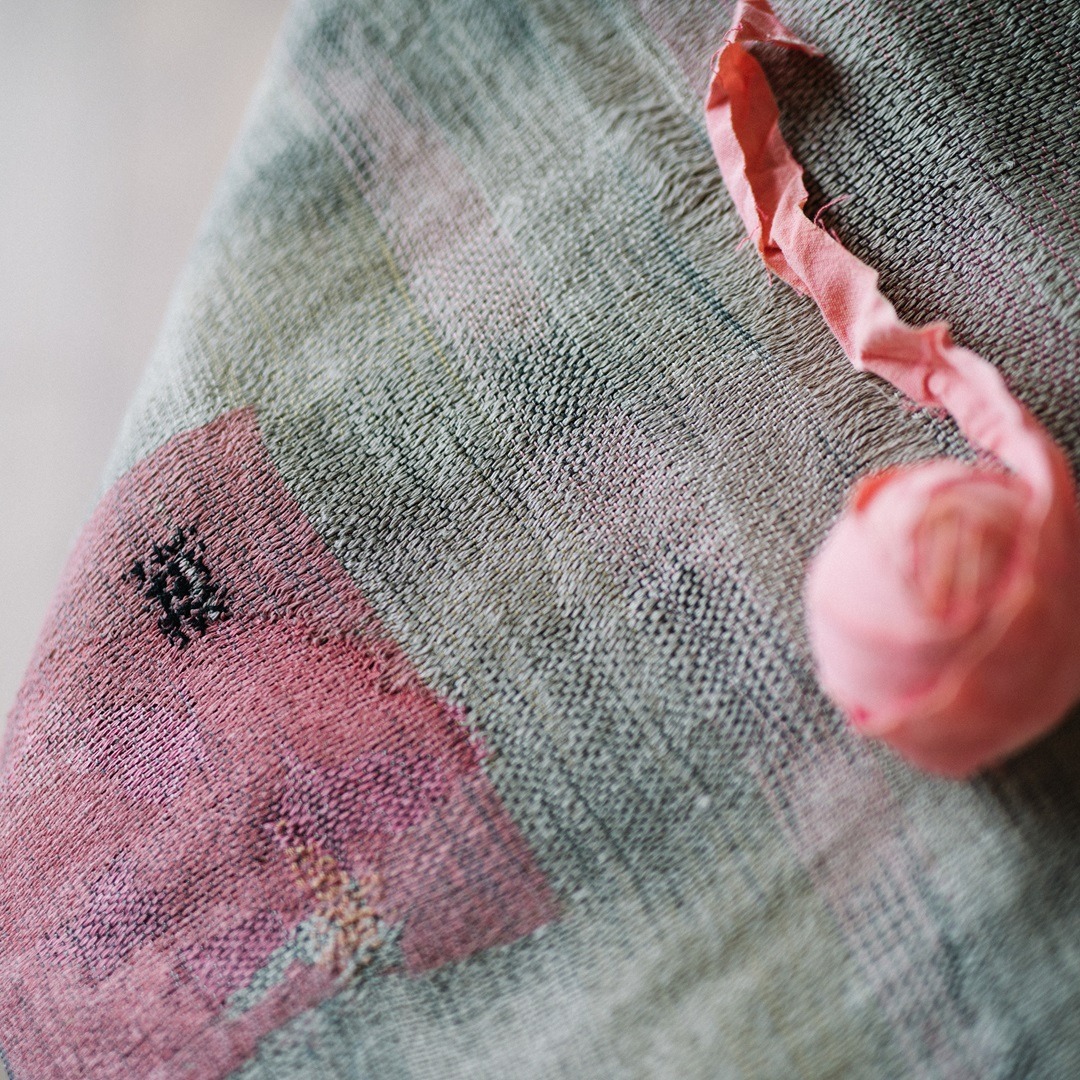
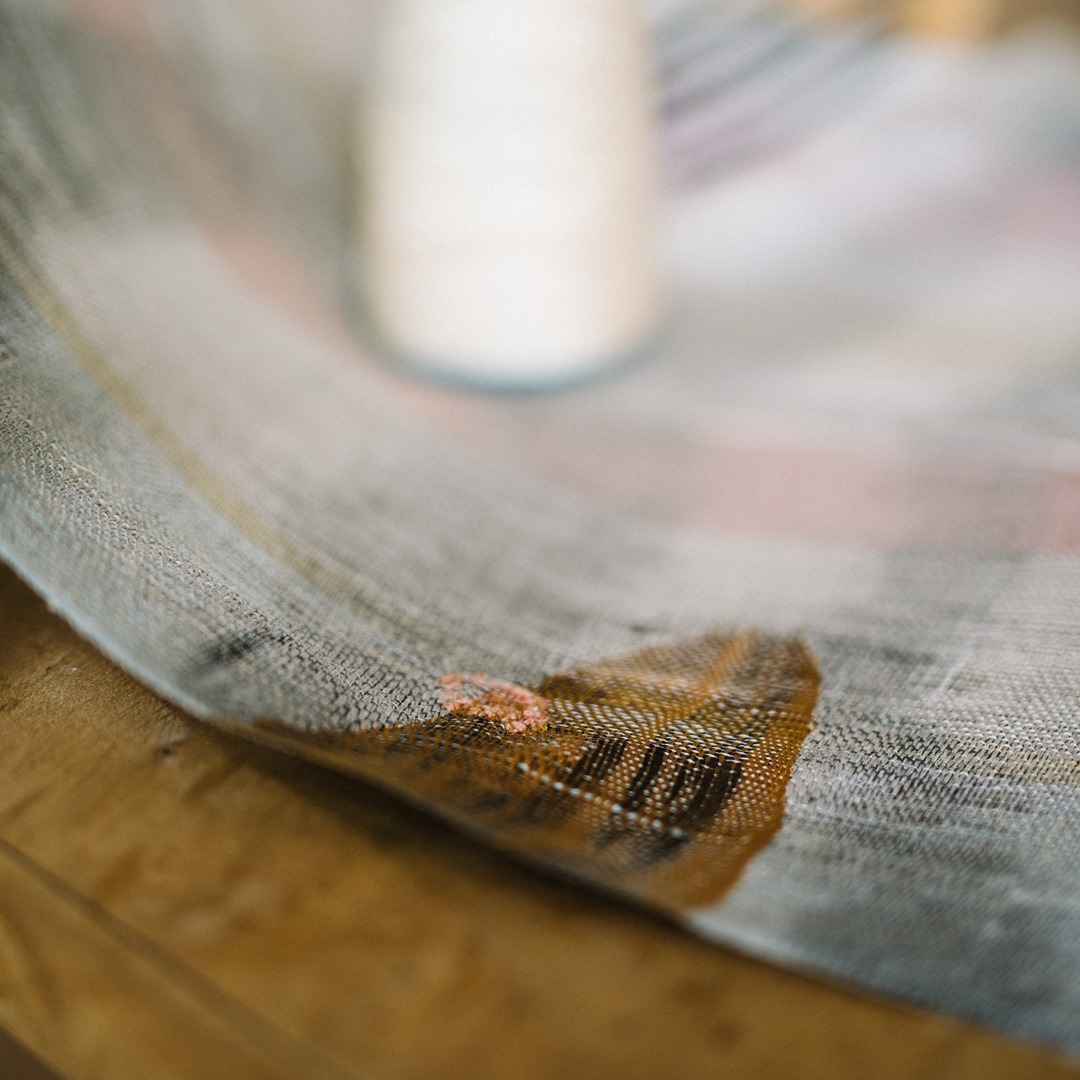
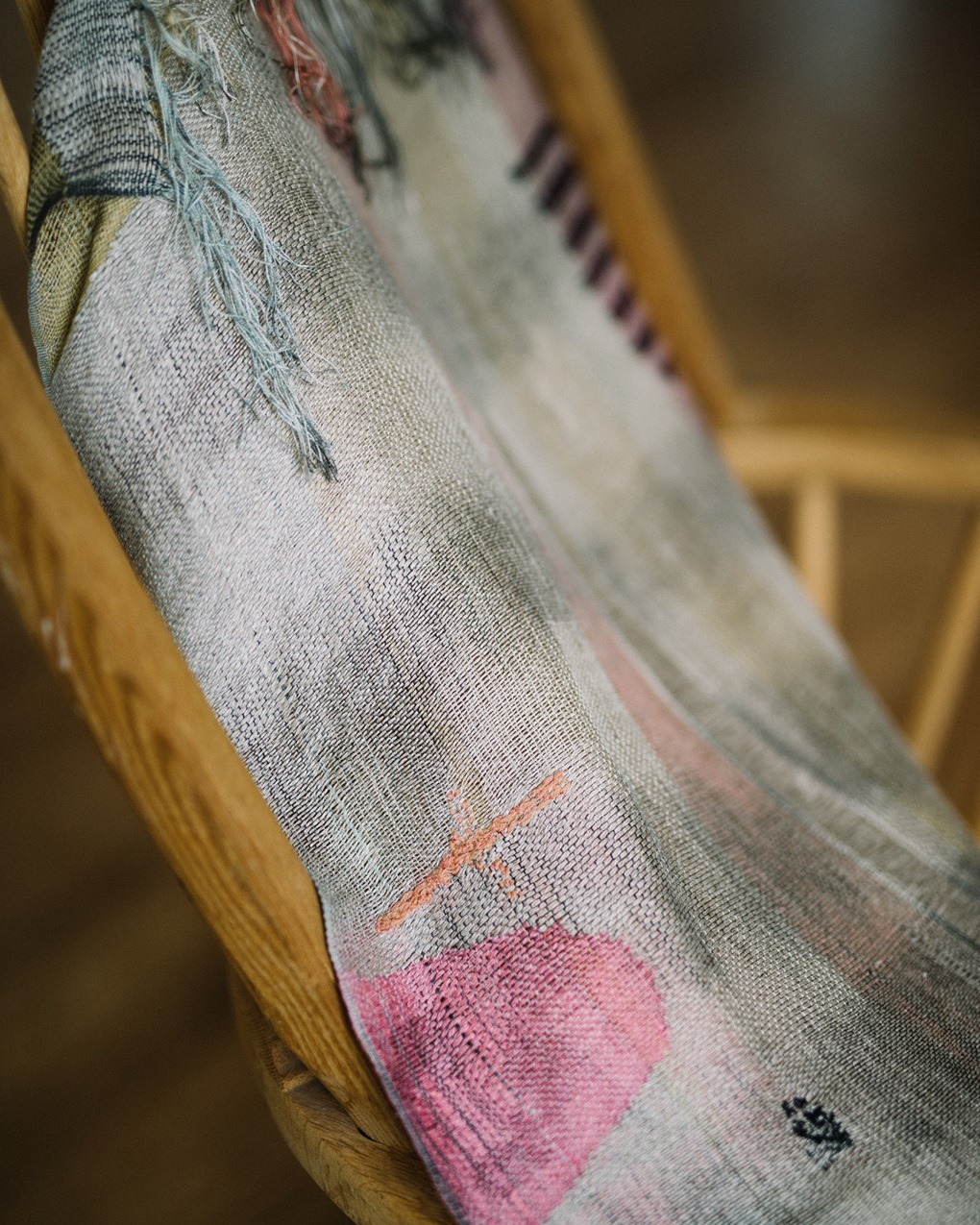
True cost of textiles
Kate Whitehead: I’ve never felt at ease with high street consumerism and the ‘more more more’ attitude.
Our magazine image of life tells us more means better, and I’ve always had an awareness of this. During my textiles degree I watched a documentary called The True Cost, a groundbreaking documentary film by Andrew Morgan that pulls back the curtain on the untold story and asks us to consider – who really pays the price for our clothing? It hit home. It’s about the clothes we wear, the people who make them, and the impact the industry is having on our world. The price of clothing has been decreasing for decades, while the human and environmental costs have grown dramatically. The mixture of my outlook and this new found knowledge was what inspired my final collection for my degree, and it continues to inspire my art practice today.
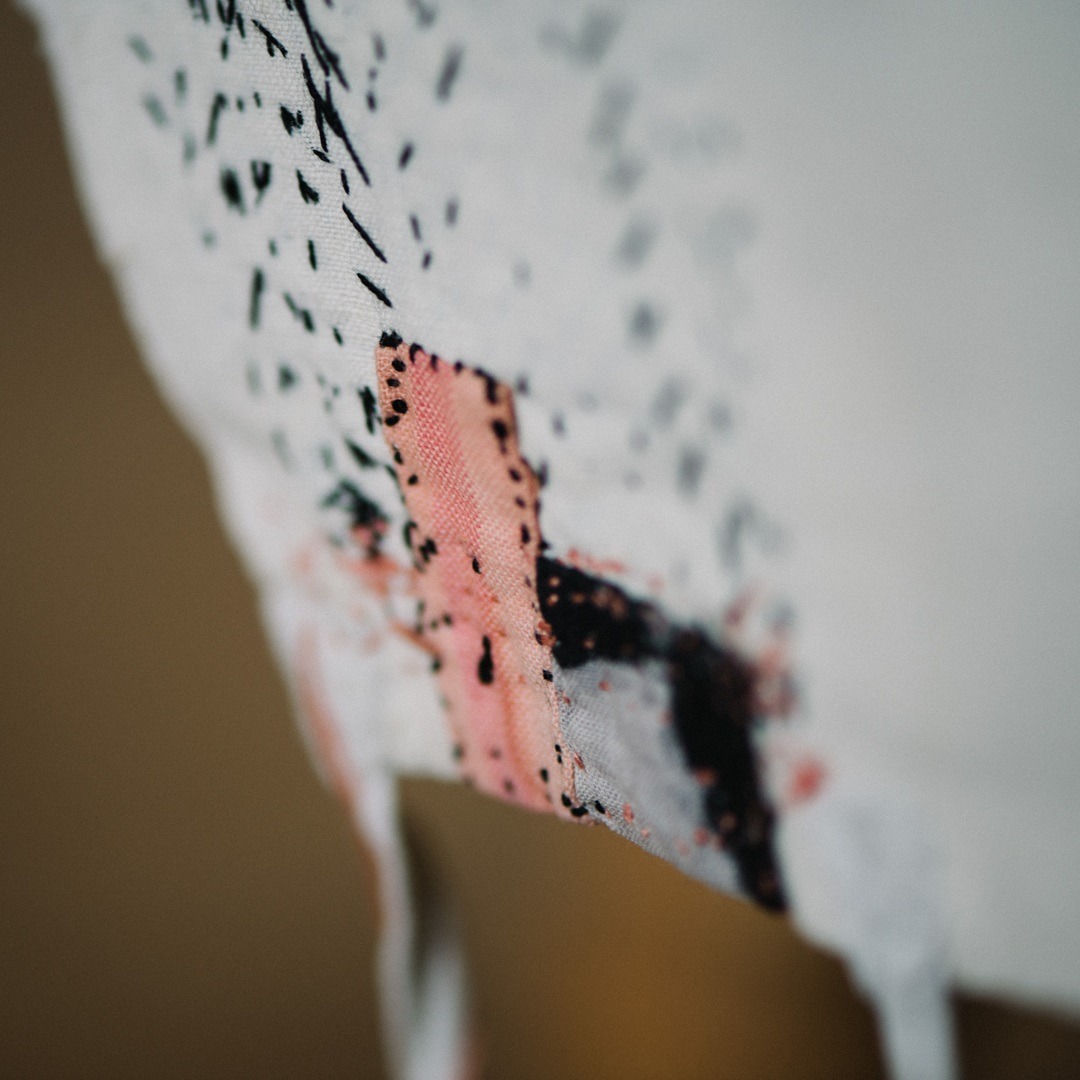
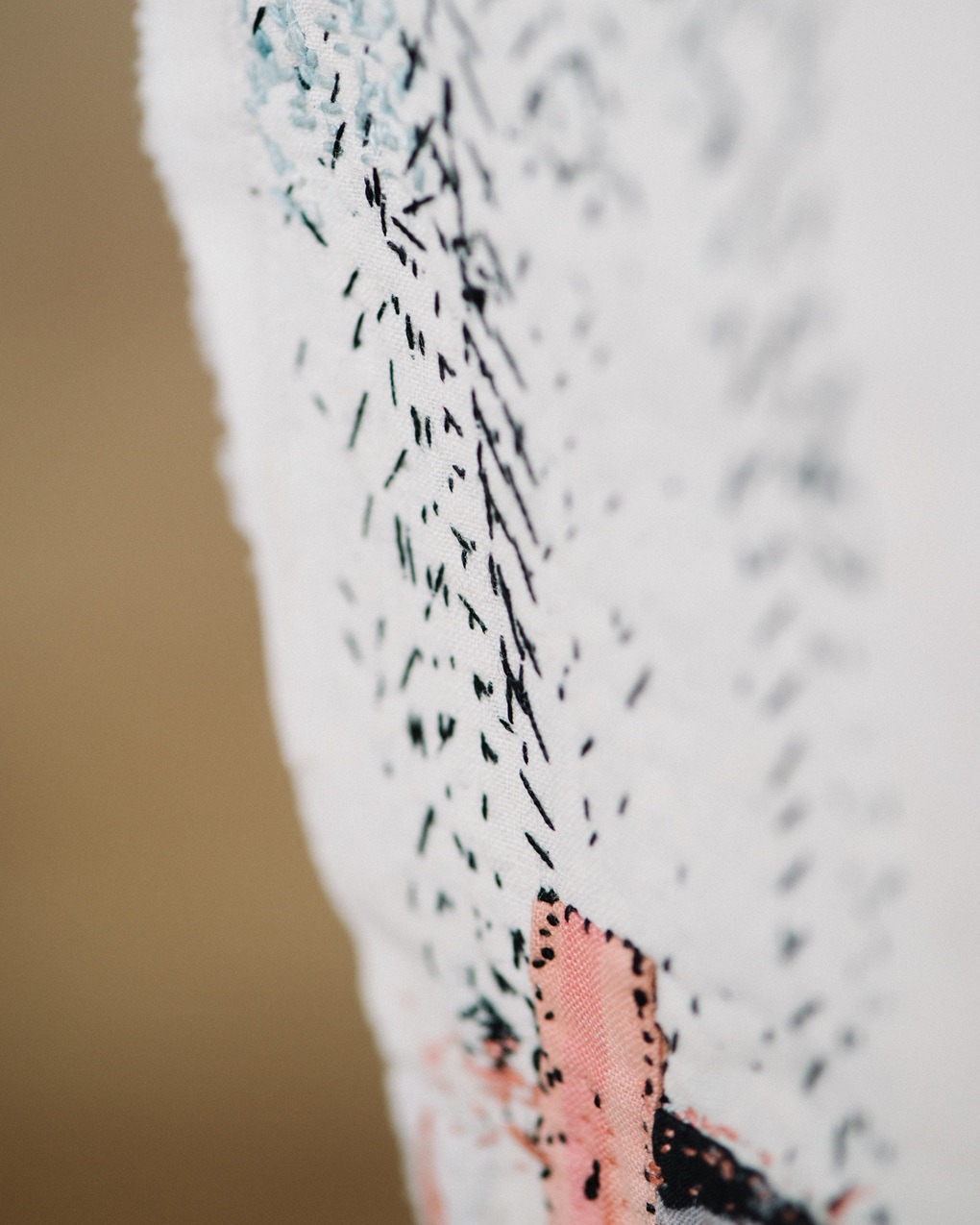
Mainstream rebellion
My collections are created around a narrative. I use what I’m feeling at the time to influence my work. What I see and sense, mixed with what I’m going through in life, informs my narrative. I take my emotions and transfer them into cloth. I find it very therapeutic. These pieces often inspire the audience to share their stories too, creating a community of expression.
From age eleven, I’ve used a camera to take quick snap-happy photographs when I’ve been in cities. I’ve focused on colours, shapes, shadows, street art and buildings. Walking around, looking in shop windows, noticing what people are wearing, looking up, and looking down. This gives me a sense of what trends are coming. I then rebel against what’s going on in the mainstream.
My process is considered, thoughtful, ethereal and delicate. My rebellion is to go back to slower processes, embrace tradition, salvage the discarded, fix the broken.
My favourite piece of work I’ve made is hanging on my wall. It’s hand woven using salvaged silk and linen with indigo running through the weft. It was made for my Not From The Stork collection that was shown in the Knitting and Stitching Show at Alexandra Palace, London and Harrogate Convention Centre in 2018. It’s particularly precious to me as it was the last piece my father saw and loved before he died.
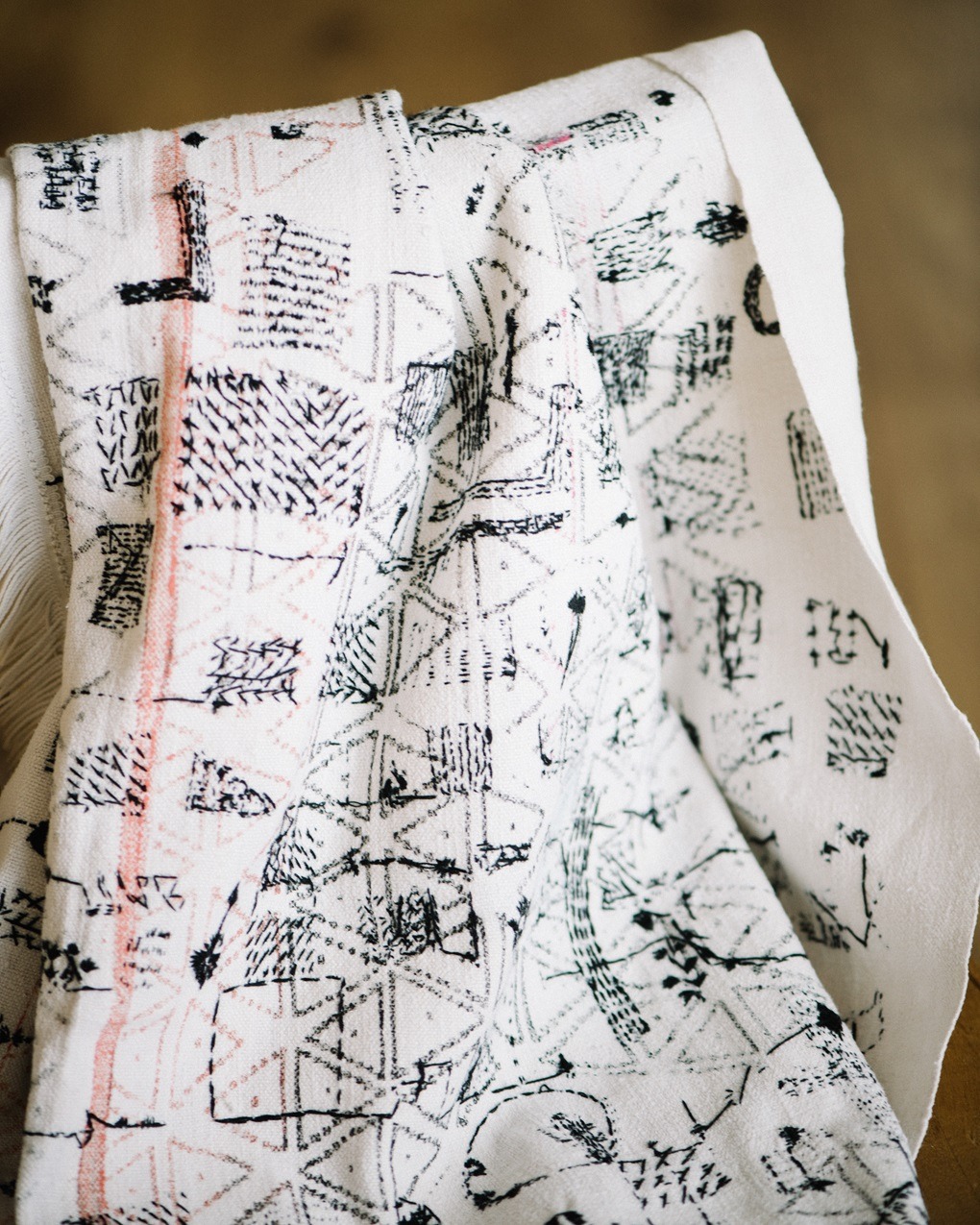
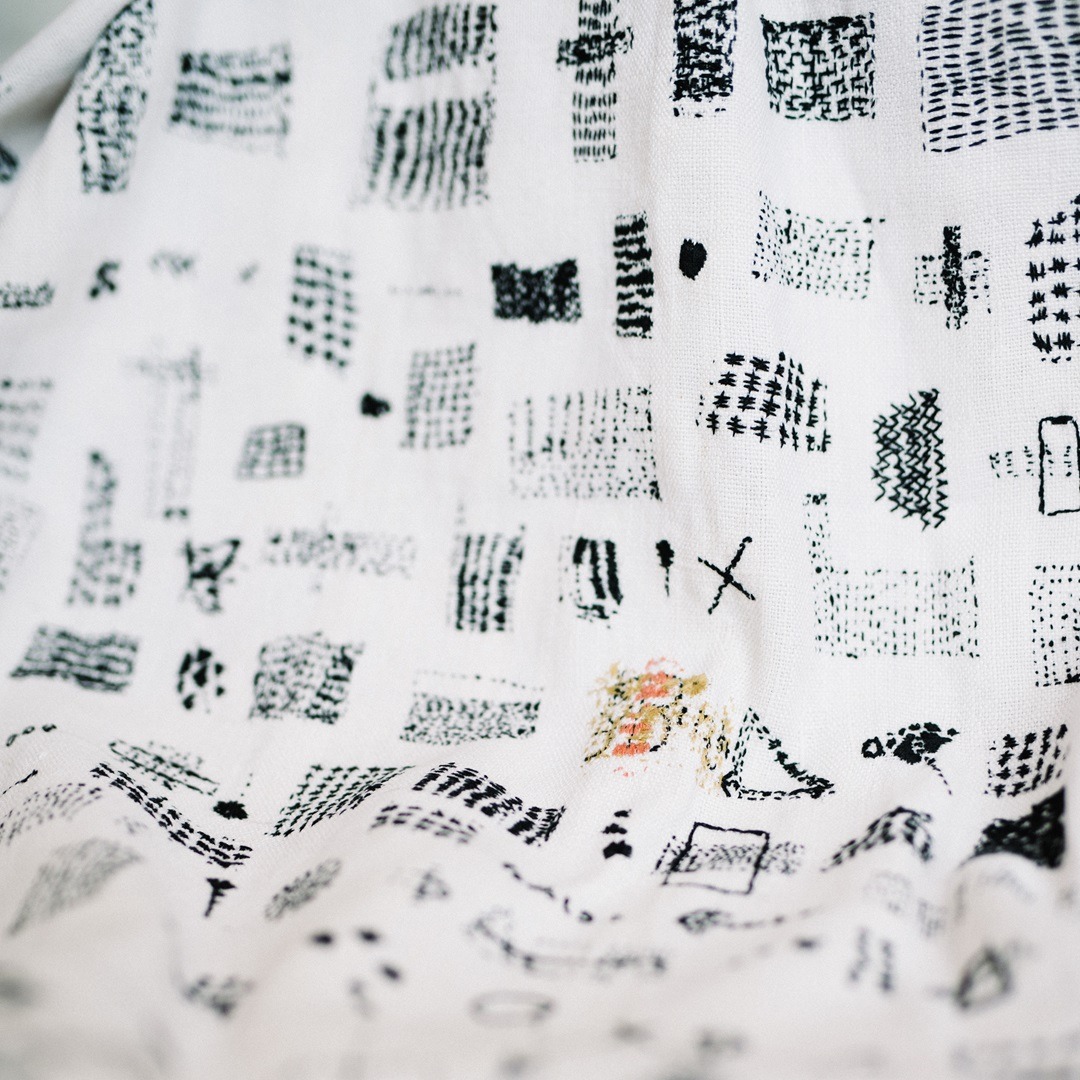
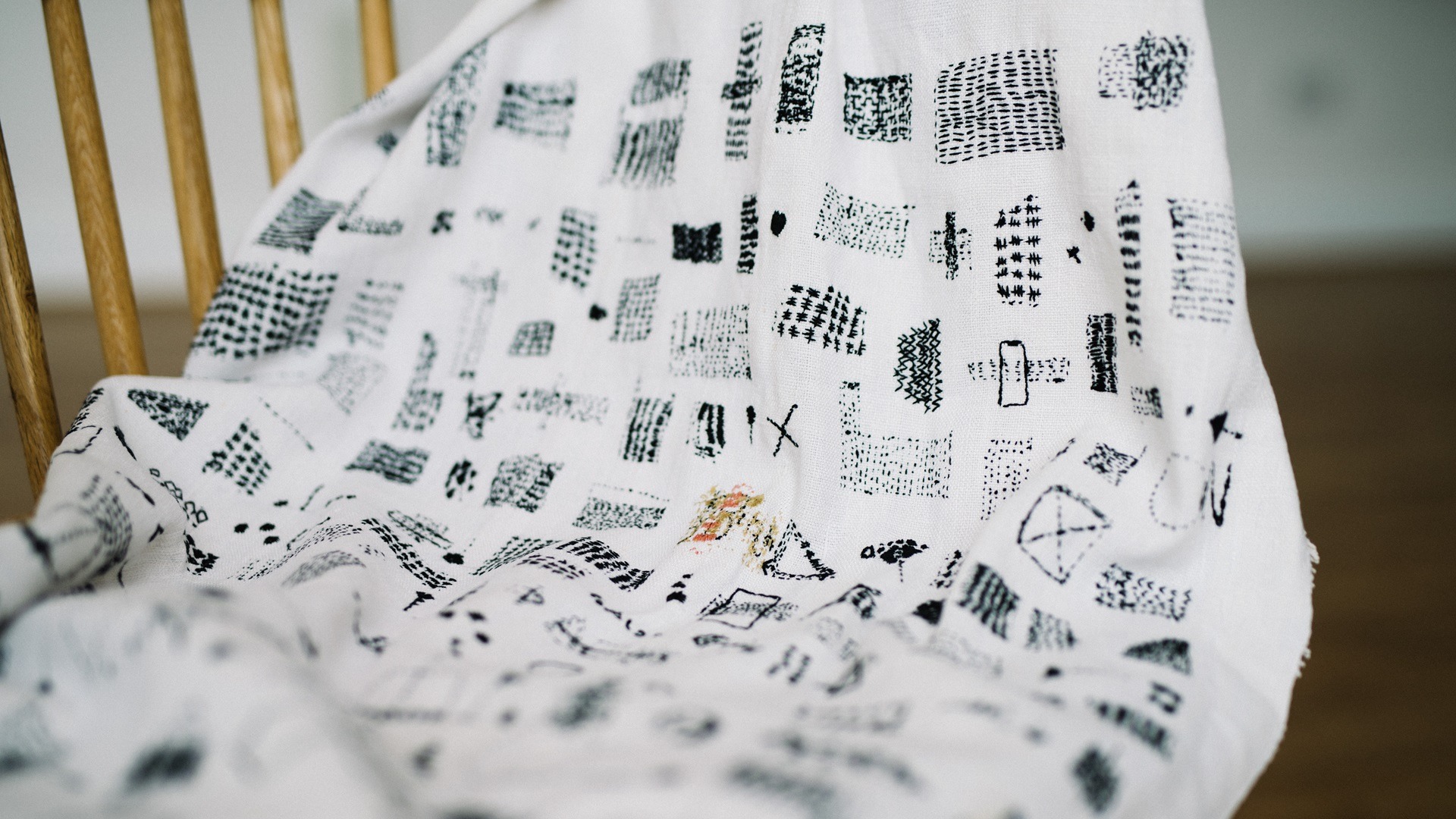
Naturally unloved
I source my materials from markets, flea markets and car boot sales, while on my trips and travels. I’m drawn towards items that haven’t been loved, nurtured and cared for, cloth mainly made from natural materials. I see something in them that I know I can bring into my practice and give them a place where they can be seen – whether it’s yarn, or fabric for a hand woven piece, or thread for embroidery.
In my weaving and embroidery, I take time to imagine the history of every piece, exploring its hues and tones, examining its tears and frays, weighing up its foibles. Recent items I’ve found are a small loom at a car boot sale, metallic thread that I am using in hand woven pieces, and a vintage kimono.
“My aim is to find a place for these bits and pieces that catch my eye.”
I’ll create something so that they can shine and have a special place of their own, to be viewed and seen for the beauty that they possess. It’s like wanting the underdog to win, a feeling that these unwanted objects or pieces or fragments of life also deserve a special space. Maybe it’s part of my DNA, or that I’ve always been creative. It’s something I’ve always done.
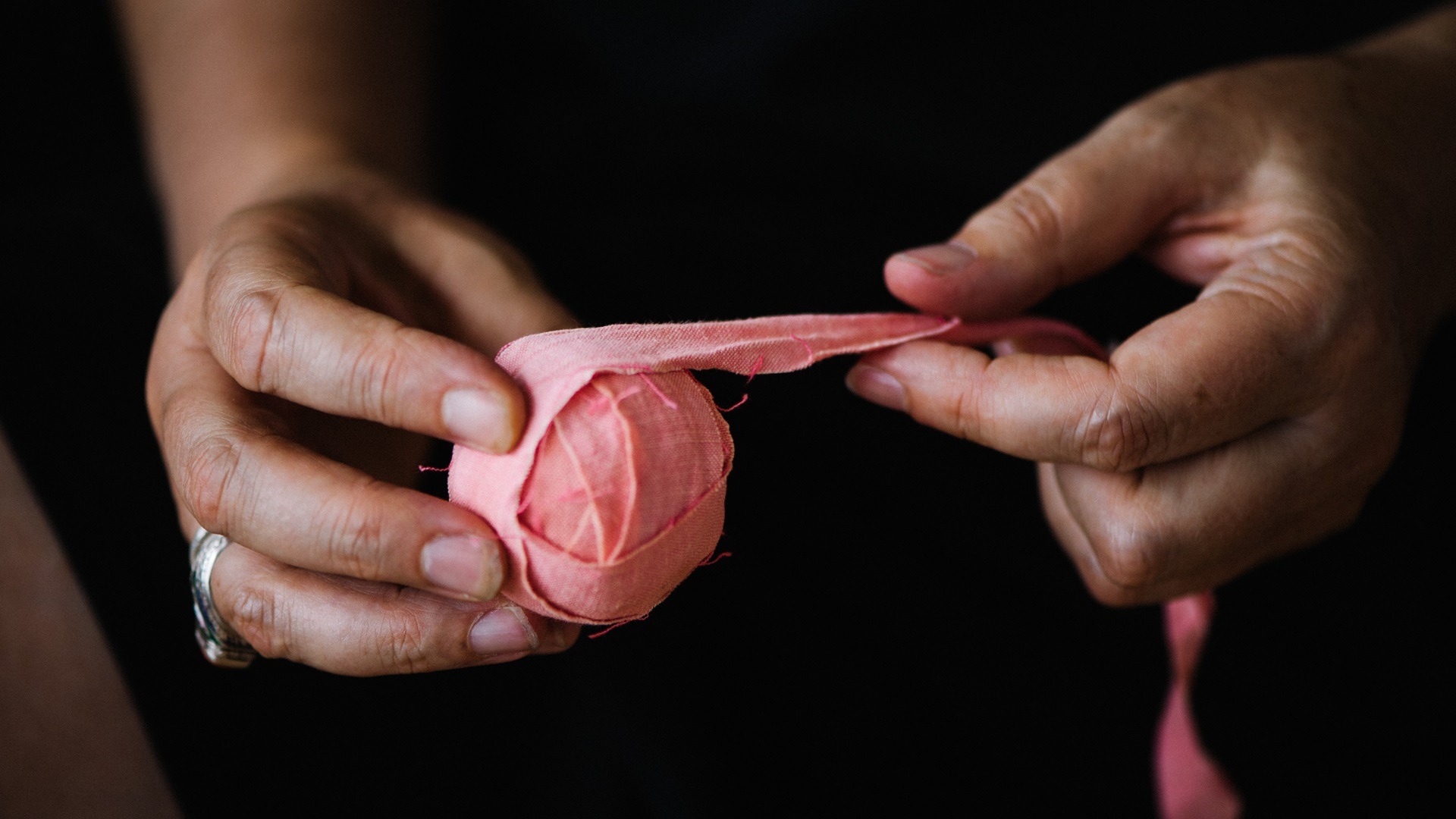
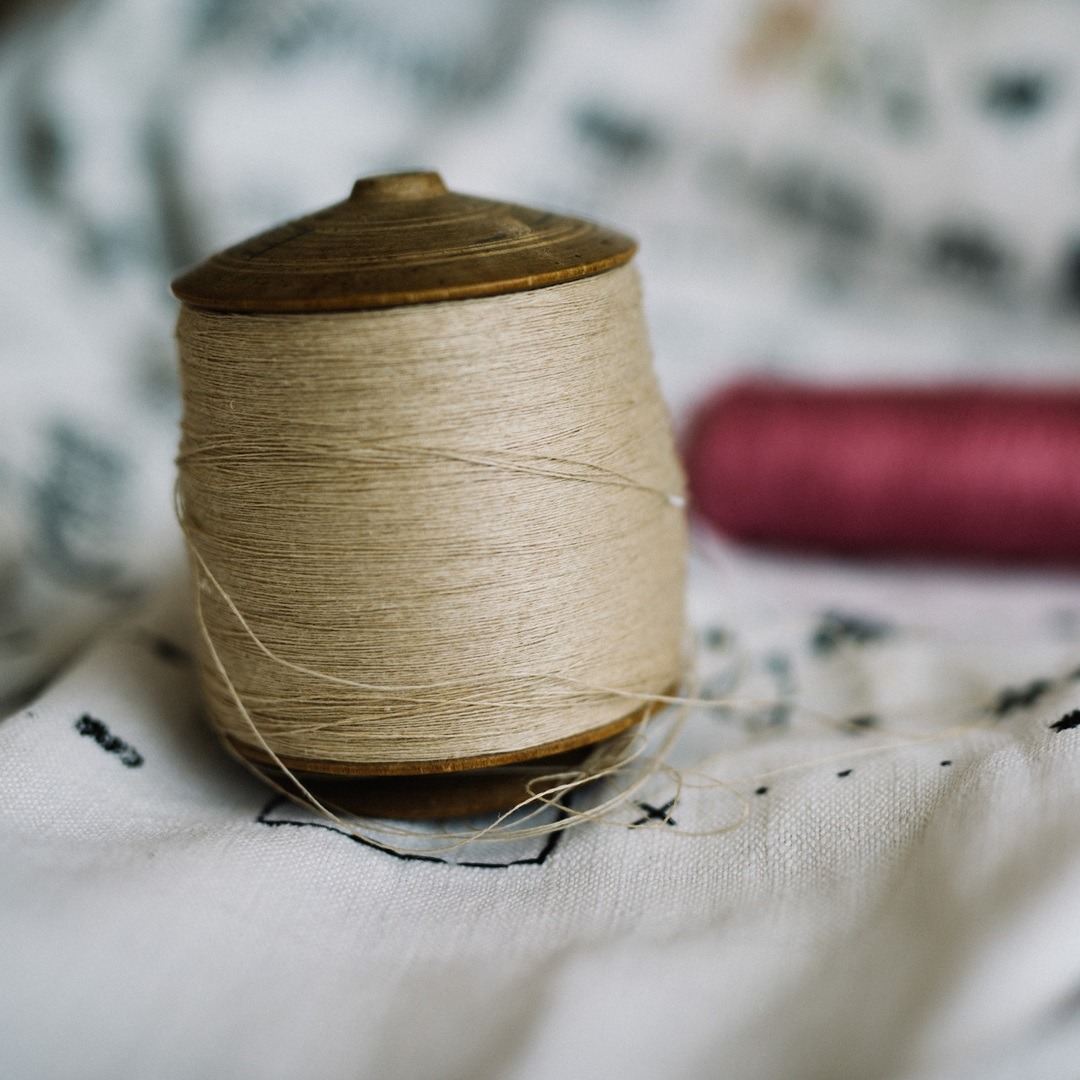
Creative childhood
I was born in London, adopted and I lived in West Yorkshire until moving to Manchester, where I’m based now. As a child, I enjoyed dressing up and was lucky to have a dressing up box to play with. My favourite outfit was a tulle pink skirt and t-shirt. My other favourite outfit was a wig, a red skirt with rickrack trim, a bikini top and a scarf.
I had a great imagination and enjoyed making things for dens. I gathered vases of flowers, made rose petal perfume, hung fabric at windows and painted stones. I collected old pottery dug up from the garden and used paint sample pots to decorate the roof. I loved cutting out paper outfits for my paper dolls. As a young teenager, I enjoyed eating cubes of jelly and would throw it onto the ceiling and let it stick. I painted my bedroom with luminous green paint and used glittery nail varnish to decorate the door handles. My walls were full of images from magazines of bands, graphic designs and tickets from gigs. I made most of my clothes, choosing fabric from the local market or off-cuts from my father’s textile mill.
Occasionally I would save up and buy pieces from Camden Market, and hair dye from X Clothes in Leeds. One of my all time favourite pieces of clothing was a calico skirt with bold black marker pen marks on it. I loved workwear and anything androgynous if I could find my size from the army and navy stores.
Juggling life and creativity
Mum noticed I was good at making things and that I had a good eye for colour and composition. I’d left school with little in the way of qualifications, so she encouraged me to go to the local art school.
School was never the right fit for me, whereas art school was. I did a Foundation in Art and Design at Keighley College for a year and thrived in that environment. From there I went to Bradford School of Art and did a Diploma in Jewellery through Art and Design. It was a brilliant course. I juggled working hard, designing and making jewellery and travelling up and down the country going to gigs.
When I finished the course, I worked for two jewellers for two years before setting up my own jewellery business. I had a stall at The Ridings Shopping Centre in Wakefield every weekend. I sold my silver jewellery there. I would take orders for different sizes of rings and bracelets, make them during the week and then sell them on my stall at the weekend.
I did that until I got pregnant – my daughter was born when I was just 22. I had my son two and a half years later and was a single mum when he was three months old. They were, and still are, my everything.
Being left with a baby and a toddler meant I had to put my creativity on hold. I found work in a clothes shop and after a while the head of display and window dressing noticed I had a creative eye. I spent three years on my day off from my part time job doing my British Display Technician Certificate at Bradford School of Art. I was juggling work, studying and caring for my children. I was young enough and enthusiastic enough to make it work.
When the course finished I worked as a freelance display technician in shops, creating window displays, merchandising and visuals for the shop floor.
“Even back then, as a jeweller and display technician before doing my textiles degree, I’ve always worked with a rebellion against consumption.”
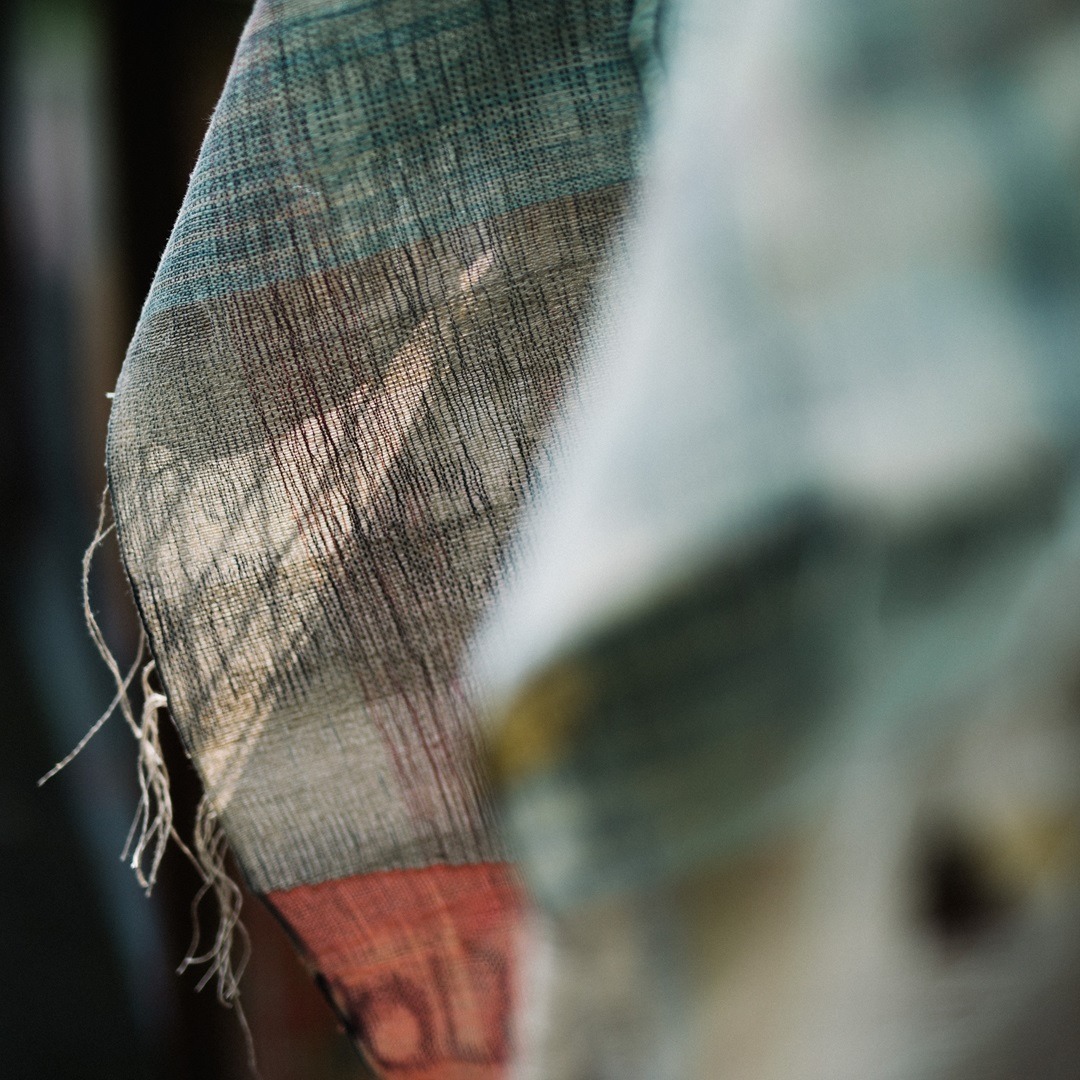
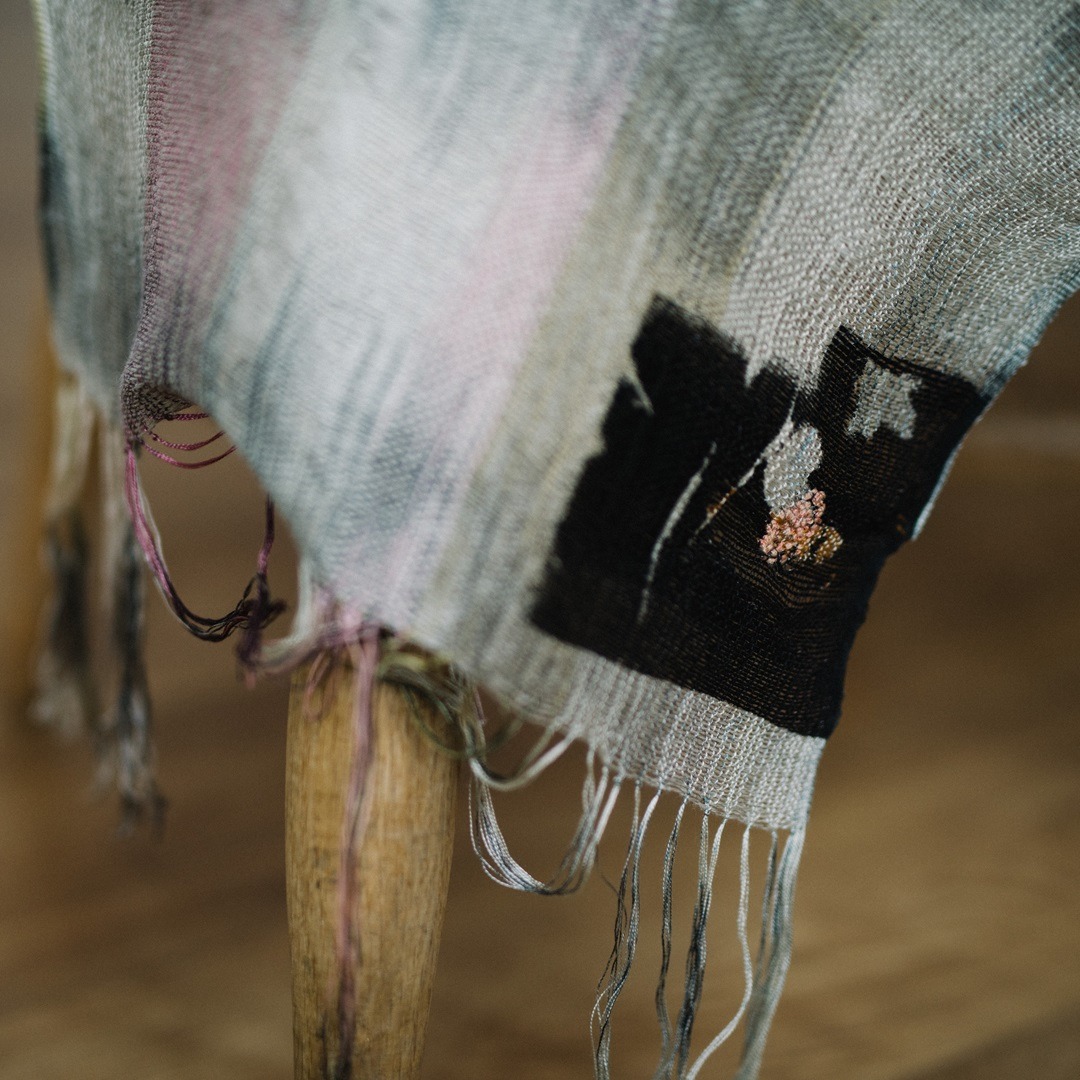
Discovering love of weave
Let’s fast forward to when I met my partner, who supported me to do my degree in Contemporary Surface Design and Textiles at Bradford School of Art, completed in 2013. My children had finished school, were doing courses and flying the nest. My degree helped with the emptiness I felt as they found their own happy paths.
I loved every minute of my degree and, having put my creativity on hold whilst my children were growing up, it was heaven to be able to express myself through art. I worked hard and gave it my all.
In the second year of the degree, we were taught to weave. We started on table top looms, learning to work out the different patterns and use different yarns. I had an instant connection with weave. Something just clicked. I loved using ideas that came to me and the physical rhythm of my hands to create woven pieces. It gave a sense of calm and was the perfect space for the soul to settle.
“Creative weaving equals rhythm – using head, heart and hands.”
With creative weaving, like a blank page, you’re never quite sure what the result is going to be. If patterns are created in a more mathematical way, you know what the outcome is going to be. That, for me, takes away the excitement and possibilities of what can be.
In the third year of my degree, I specialised in weave and embroidery. I had a passion for using fabric, yarn and materials that nobody wanted. This, and my love of combining colour with creativity (without using mathematical patterns), helped me to win awards, including first prize in the Holland & Sherry award for a woven fabric in any fibre or blend, and four from the Clothworkers’ Foundation. Having won a sponsorship from the embroidery thread manufacturer Madeira, embroidery is also a constant in my practice.
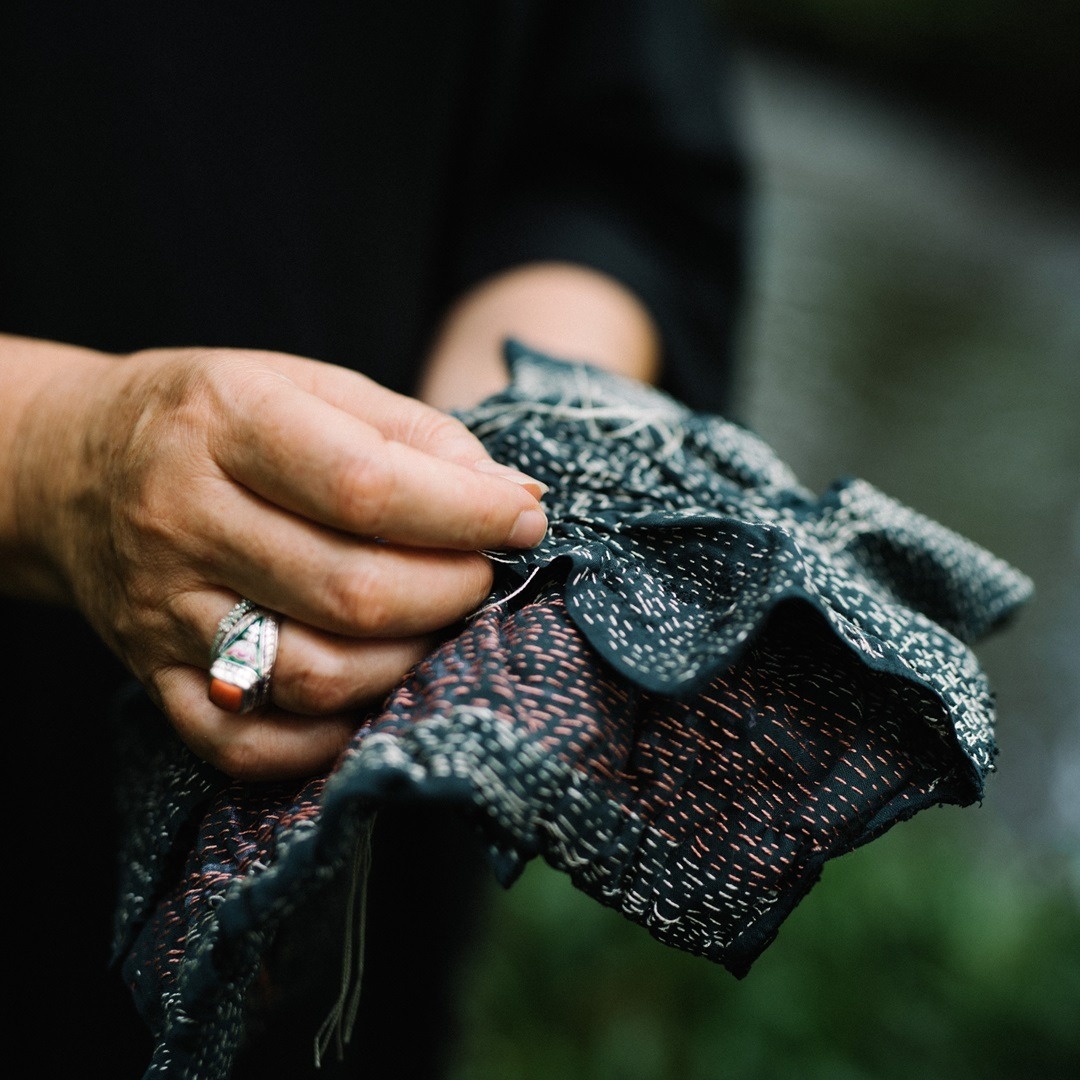
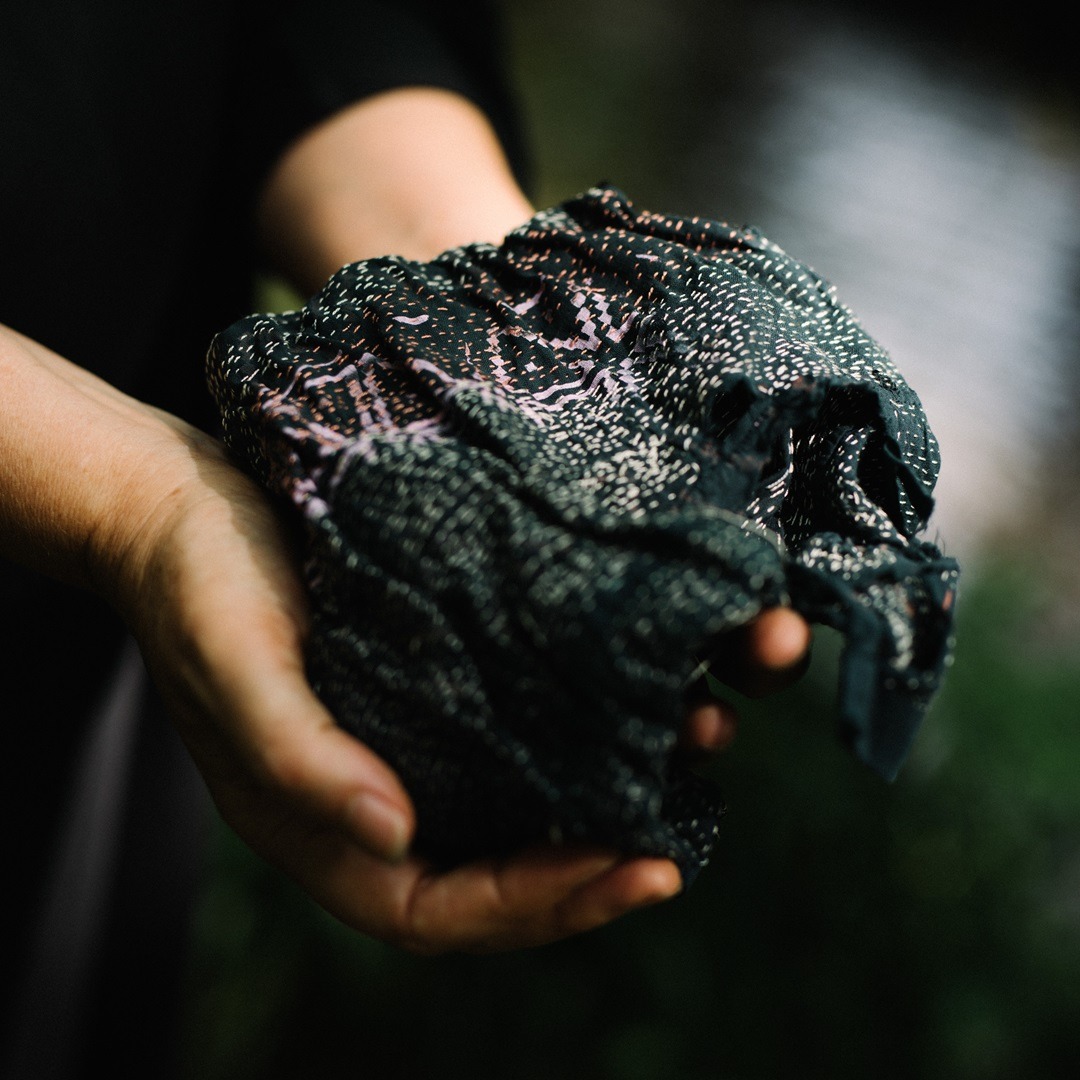
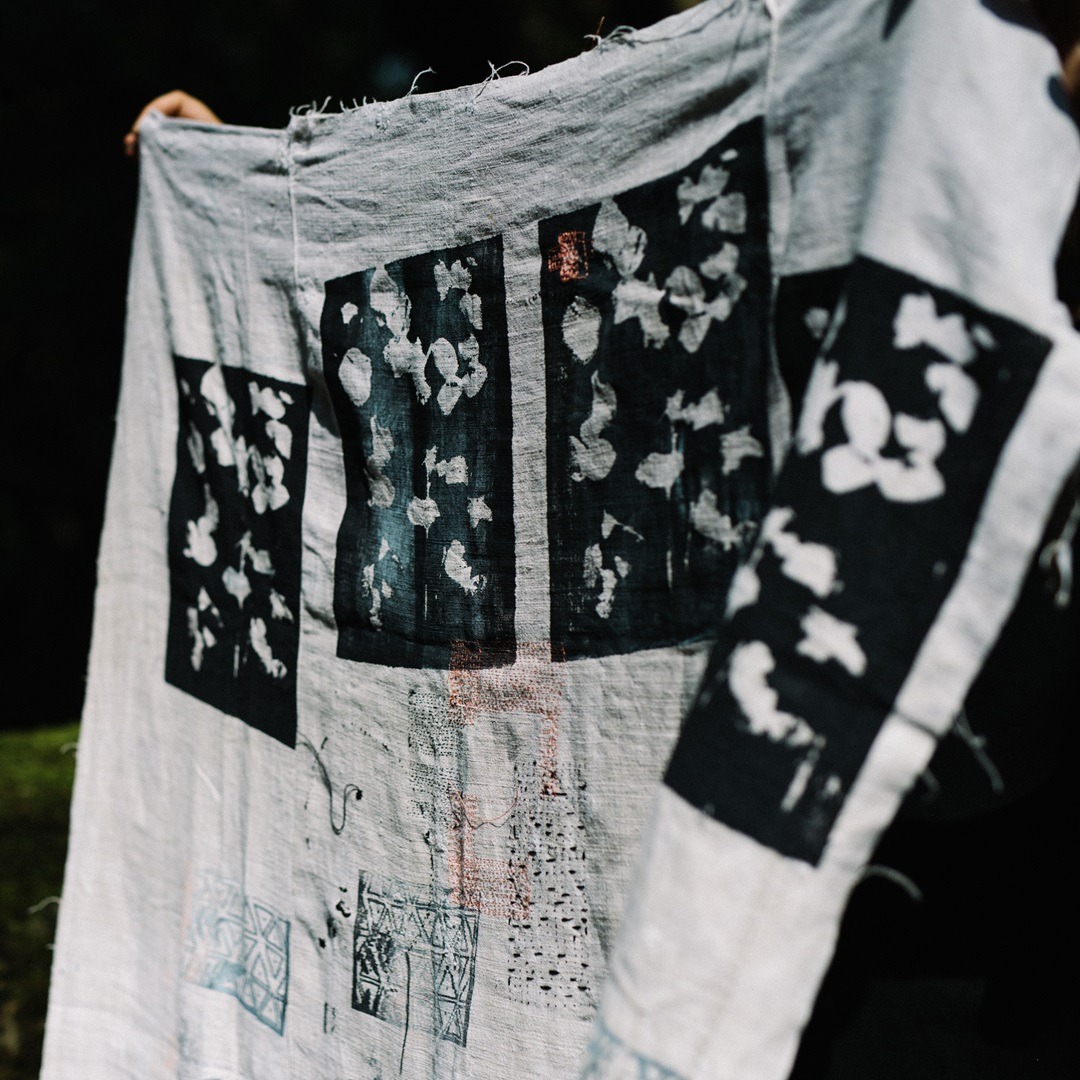
Beauty of poor materials
The fashion students would use calico to make toiles that I thought were beautiful. When they had used them to get the right design for their garments, they would sometimes throw them in the bin. I often preferred the toiles to the finished garment made in more luxurious fabric. I took these unwanted toiles, dyed them in indigo and stitched into them. That, and my eye for unwanted materials, formed my final collection in my degree, which I called the ‘Beauty of Poor Materials’.
This collection comprised hand woven and embroidered pieces using materials and yarn that I’d found. It included a kimono I made from found material, over-dyed and embroidered. There was a second hand chest of drawers with hand woven, embroidered and printed pieces, and a chair I found and restored, making a hand woven seat.
While working on the kimono, I was introduced to Boro, a class of Japanese textiles that have been mended or patched together. The term is derived from the Japanese term ‘boroboro’, meaning something tattered or repaired. Boro textiles are typically dyed with indigo dyestuff, historically having been the cheapest and easiest to grow dyestuff available to the lower classes.
I dyed areas of my final degree collection with indigo, madder and nettle. I continue to use this concept, dyeing areas of materials or yarns that are stained, worn, or perhaps not quite the right colour for the piece I’m working on.
I don’t grow my own natural dyes: my practice and the work I produce is a slow enough process. I buy the dyes online and make my own dye vats.
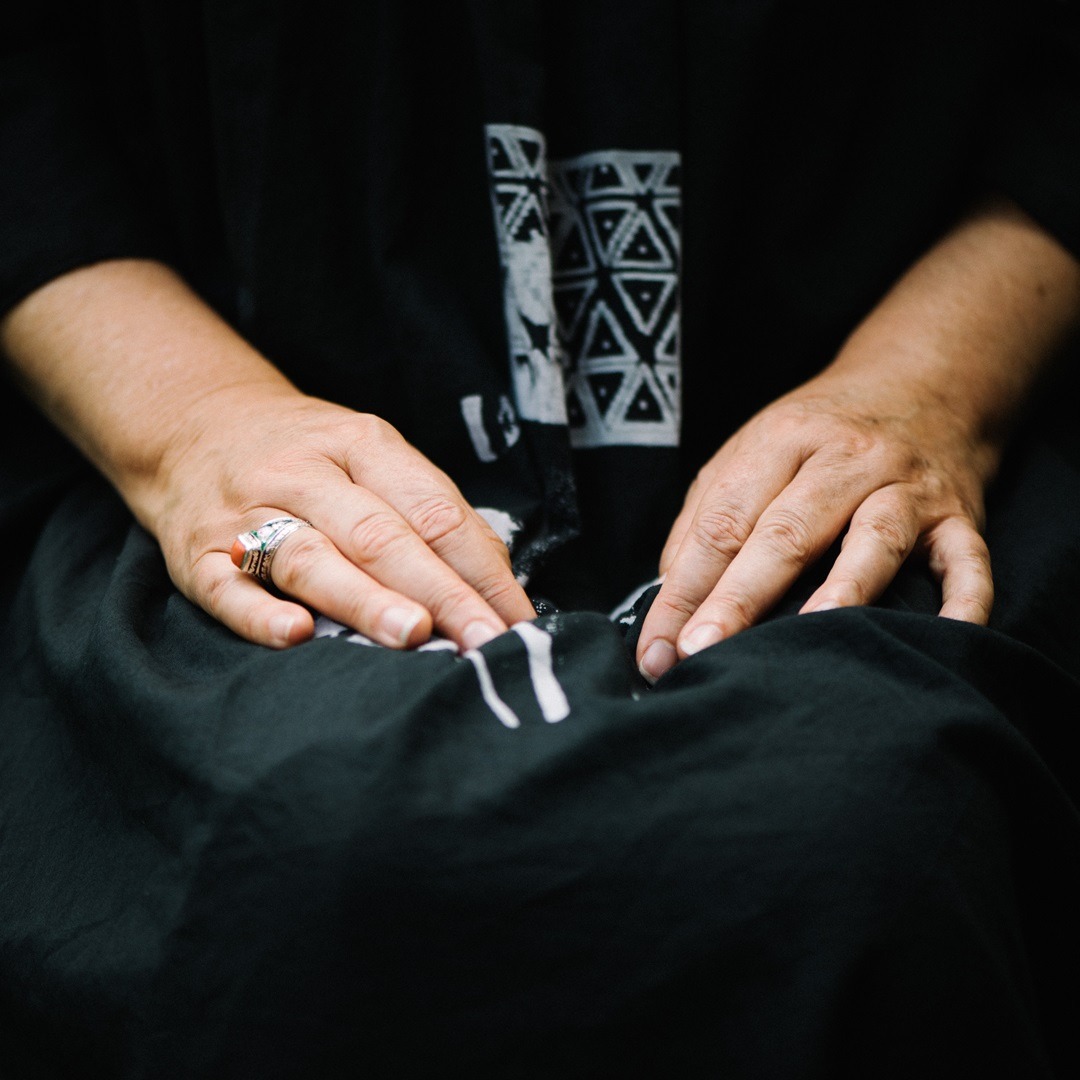
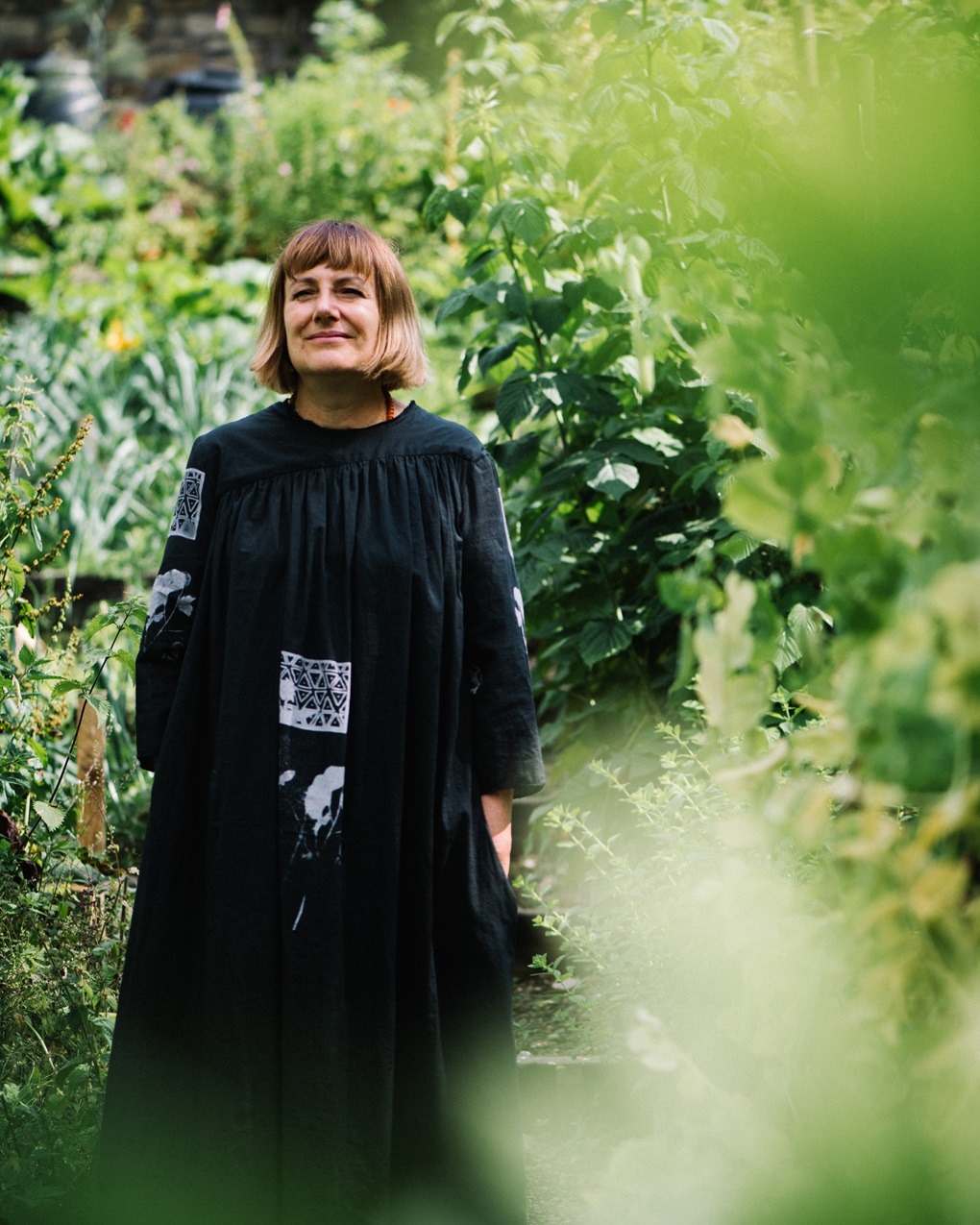
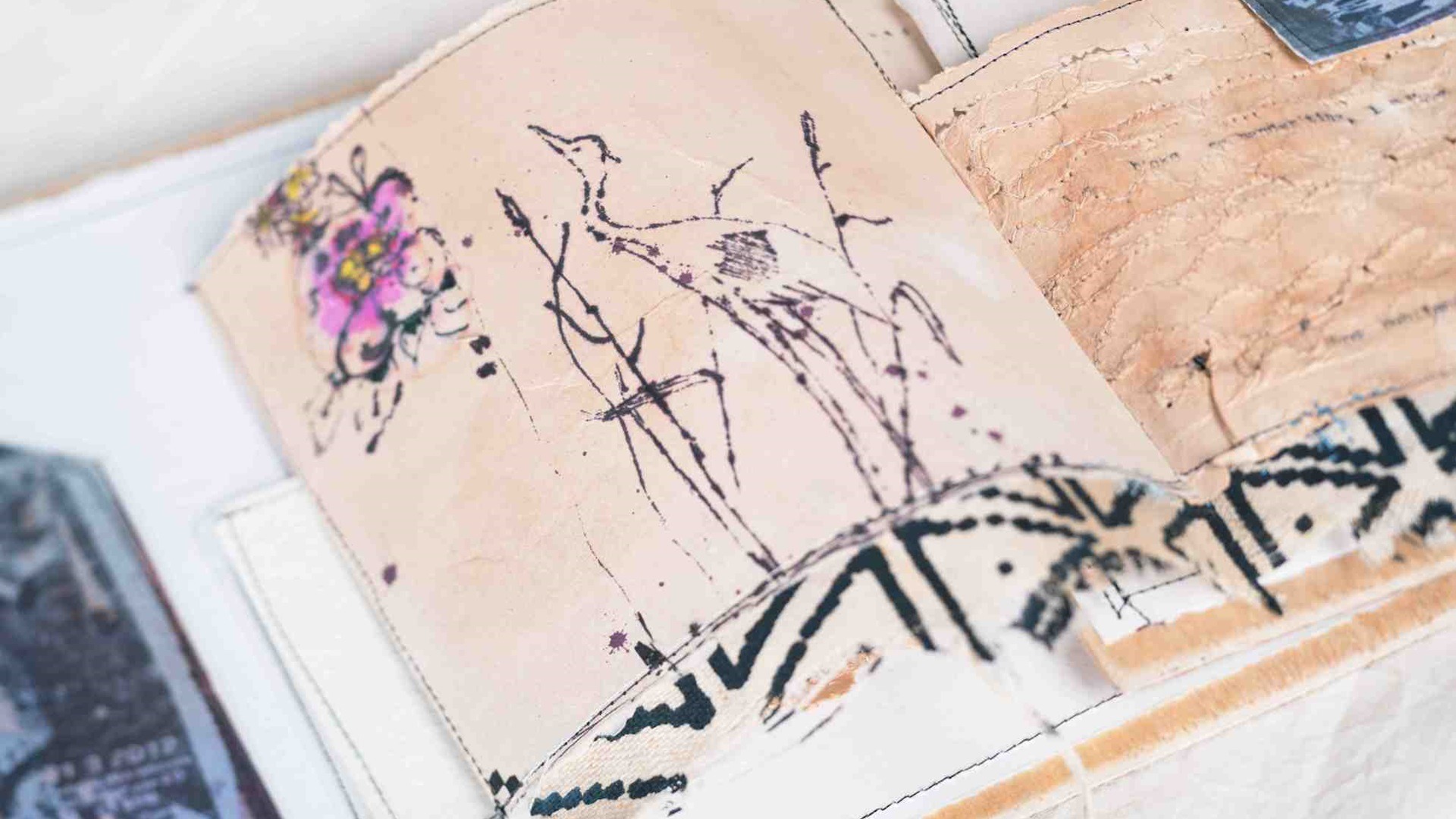
Becoming an artist
I was awarded a first class honours degree and, along with my fellow graduates, I showed my collection at New Designers in Islington. Also known as the London graduate design show, it’s the annual showcase of the UK’s most innovative and emerging design talent. My work was selected by Selvedge magazine to be displayed in their shop window in Archway, London.
From there I was selected for shows and exhibitions, and I went on to study Print and Weave at the University of the Arts London Central Saint Martins – Dual City Istanbul & London. But after exhibiting at shows for three years, something wasn’t sitting right. I gained a place on the Crafts Council’s Hothouse 2016 programme. Delivered over six months, it was designed to support talented artists and makers at the start of their career. This gave me the opportunity to define my textile practice and identity.
“The Hothouse programme mentoring unravelled my practice. It gave me a stronger creative identity and the realisation that I’m an artist, rather than a maker.”
Since then I have been exhibiting and selling pieces I show, and I’ve been invited to teach workshops in the UK, France and Morocco.
Film collaboration
Being closely affiliated to Bradford School of Art, I’ve been the AA2A (Artist Access to Art Colleges) artist in residence in 2020/21 and again in 2023/24, for a film I’ve been collaborating on with Alex Crystal. In 2021 I was a creative technician on a film he directed, The fight and flight of non-saint Henry. I have huge admiration for Alex and in January 2022 we decided to make a film based on my textile practice. Our first year was spent working without a budget. As time went on, family and friends helped out too – it became an incredible collaboration.
The film is called Kate and we completed it in 2023. I plan to create large print pieces to show with the film at an event at the School of Arts. Hopefully I will be able to show the film in other venues, too.
I believe my artistic emphasis comes from a mixture of having an empathetic nature, an artist’s eye and looking out for all that can be given a second chance in the world. I’m delighted that my textile art is going to be available to a wider audience who may share in that ideal.
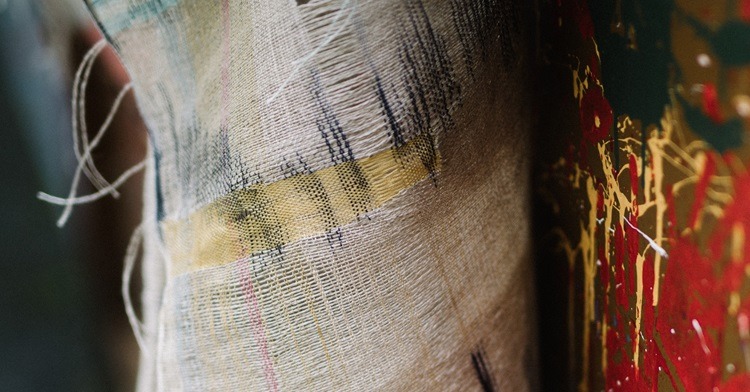

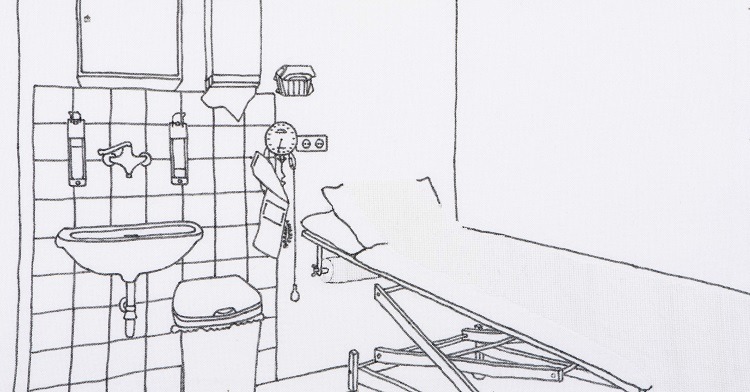
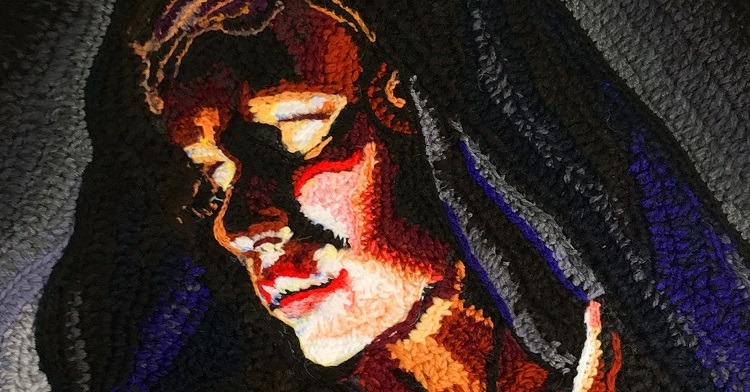
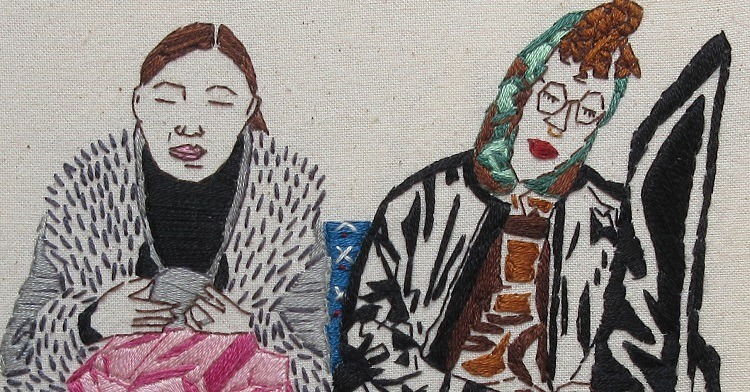
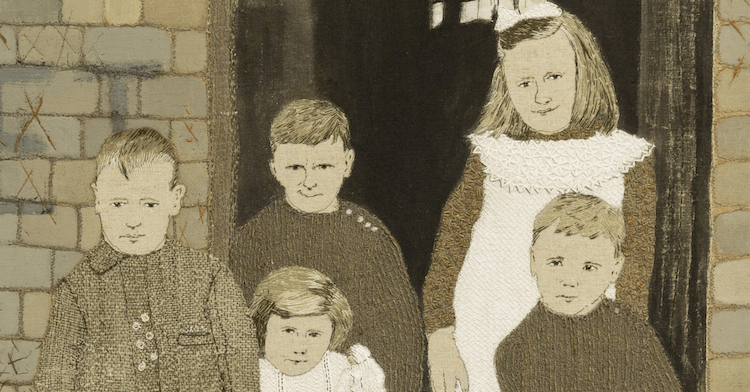
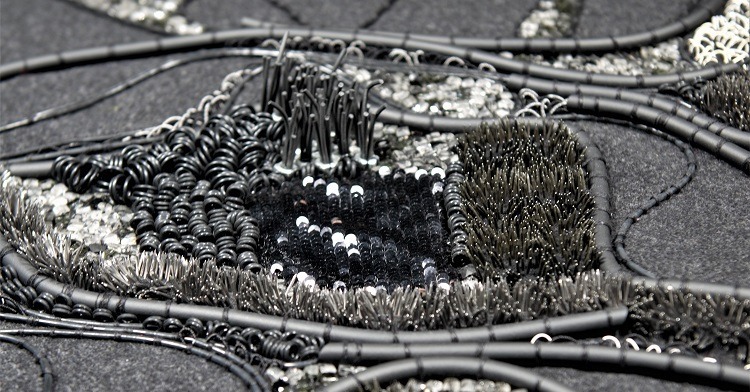
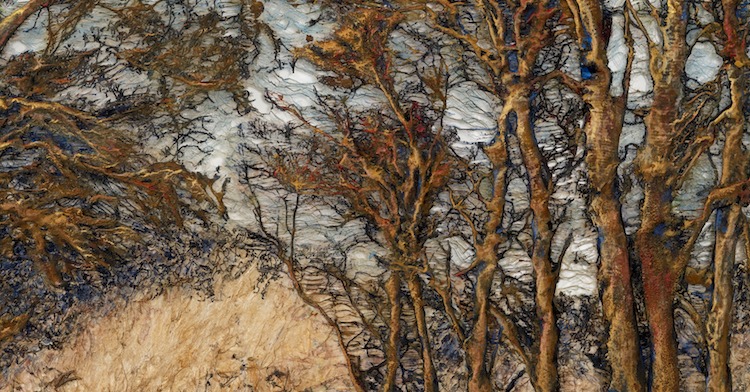
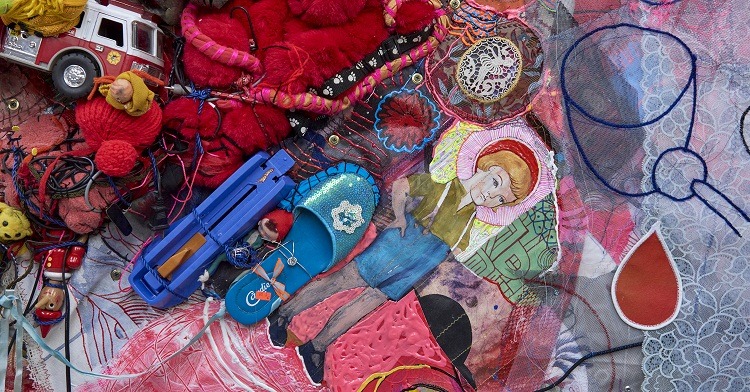
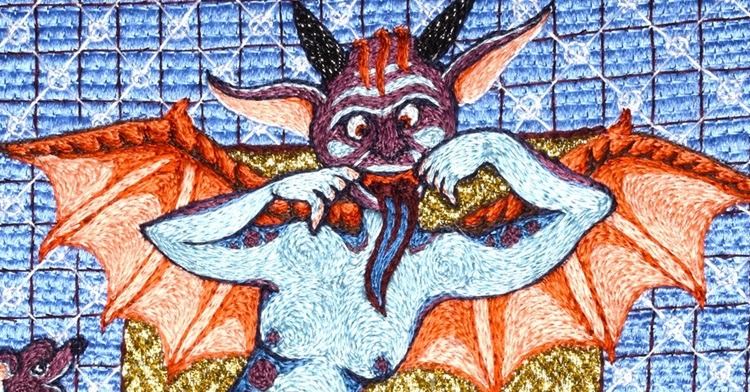
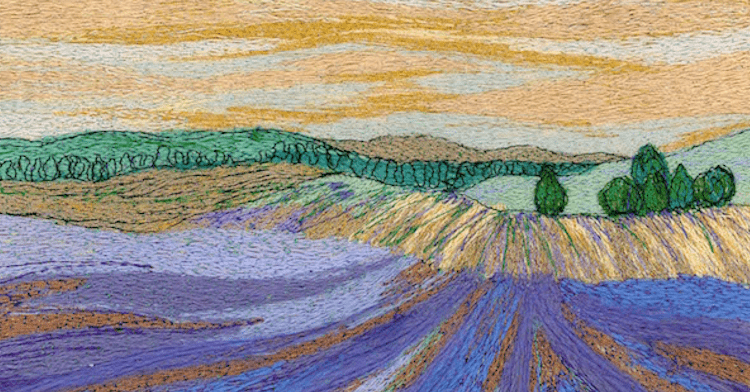
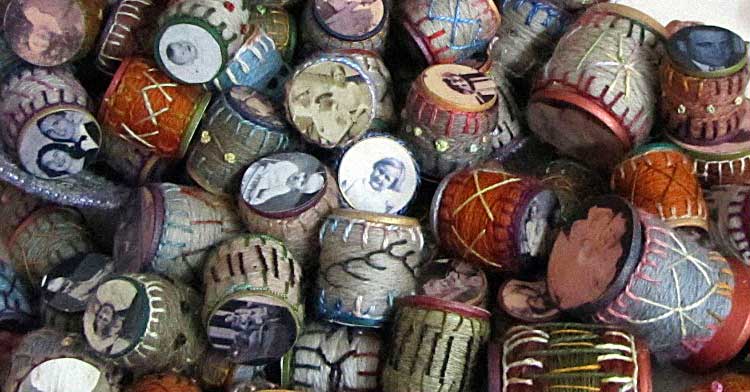
Comments